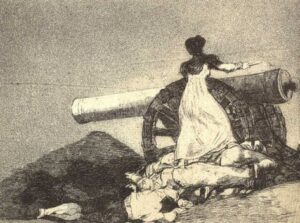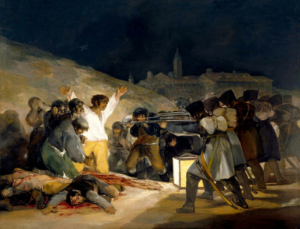Last week Trudy Rubin, The Philadelphia Inquirer foreign correspondent, compared the bombing of Guernica with the destruction in Mariupol, Ukraine. Guernica, the Basque town destroyed by German planes during the Spanish Civil War, was immortalized by Picasso in his monumental painting by the same name and was the subject of an earlier post here. Also last week, the art critic of The New Yorker, Peter Schjeldahl, wrote about “How artists have pictured conflict” in “Facing War,” illustrated with an intaglio print from Francisco Goya’s series “The Disasters of War” (1810-1820).
Goya (1746-1828) was born in Zaragoza, Spain, the fourth child of a modest family. After painting some religious frescoes in his native city, he studied in Italy before being welcomed in Madrid, where he started painting sketches for the Royal Tapestry Fabric, which display his interest for popular traditions and daily life. He was already in his forties when he was named Royal Painter by the king, Carlos IV. His most famous paintings of the king’s family and courtesans, such as his “majas” nude and clothed, show his training as an Enlighted artist in the French manner.
After a serious illness that rendered Goya deaf and sickly for the rest of his life, he painted his “Caprichos,” a series of 80 aquatinted etchings that depicted human foibles, full of wit and sardonic humor. When the French troops of Napoleon Bonaparte invaded Spain, Goya was traumatized by the horrors he witnessed and he produced his next series of etchings, “The Disasters of War,” which prelude his “Dark Paintings” at the end of his life when he was dying, isolated from the court, and practically in exile.
What Goya appraises in his 82 “Disasters” is not only violence itself, but what it brings along with it, like hunger, desolation, death. It’s worth noticing that at least 18 of these etchings emphasize the role of women as victims and protagonists during the war: “Women Give Strength,” when they are fighting alongside the men; “And They are Fierce,” when a mother with a child on her hip attacks a French soldier; “To Bury and to Silence,” the woman crying in the presence of dead bodies; “The Woes of War,” the bombing of civilians with a woman in the foreground; “Unfortunate Mother,” whose orphan child cries behind her body. And so many more.
Perhaps the most famous of these brave women is Agustina de Aragón in “What Courage,” referring to her defense of Zaragoza, Goya’s hometown, as she fought with a cannon over the bodies of her dead allies. “The Disasters of War” were not allowed to be shown until 1863, thirty-five years after Goya’s death.
Also censored was “The Third of May, 1808,” one of his most famous massive oil paintings, which didn’t get hung at the Prado Museum until 1834. Incidentally, this painting was damaged when it was evacuated to Valencia during the bombing of Madrid in the Spanish Civil War and has recently been completely restored. The composition focus on the civilians murdered at night in the outskirts of Madrid, with its buildings in the background; one man has bled to death on the left. The French soldiers on the right remain impersonal and faceless in identical uniforms. The most striking figure is the terrified man with his arms open in a Christ-like pose.
On one of my last trips to Madrid I saw an exhibit that showed Goya’s “Disasters of War” as if it were an early example of war photography: “Goya, Chronicler of All Wars.” Its poignant catalog includes photographs of the Crimean War of 1854-56, the American Civil War, the Spanish-American War, World War I, the Spanish Civil War, World War II, Vietnam, up to the First and Second Golf Wars when television brought us direct coverage for the first time. Needles to say, an exhibit of this kind would have to include nowadays the horrific magnitude of Ukraine’s invasion by the Russian forces.



Concha I missed Trudy Rubin’s cf of Mariupol and Guernica and now you
add Goya’s disasters. You say a great deal in this short piece…thank you.
Rosina
Thank you, Rosina!
Concha
Very moving, Diane
Thanks, Diane. It’s impossible to be my lighthearted self with what is going on…
Concha
Excellent, Cheryl
Thanks, Concha
The “Third of May” is the most powerful to me. Indescribable horrors of war.
Thank you for the Epilogue.
Alan
Thanks for reading, Concha
Querida Concha:
Me ha encantado tu artículo. Muy bueno, Ángeles
Muchas gracias, Ángeles. Con todo lo que está pasando en Ucrania, se me van las ganas de hacer bromas en mi blog…
Besos, Concha
I learn so much from your blogs!
Thank you
Joan
Thank you for being such a faithful reader, Concha